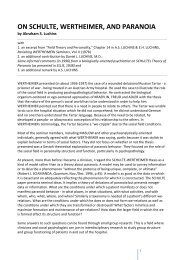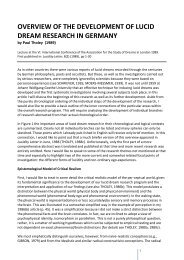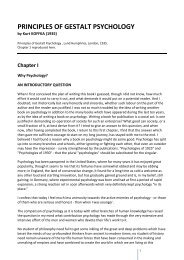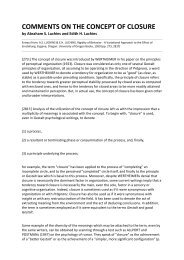pdf-Download - Society for Gestalt Theory and its Applications (GTA)
pdf-Download - Society for Gestalt Theory and its Applications (GTA)
pdf-Download - Society for Gestalt Theory and its Applications (GTA)
You also want an ePaper? Increase the reach of your titles
YUMPU automatically turns print PDFs into web optimized ePapers that Google loves.
Primary social atomism is, as has been shown already, a subspecies of reductionism. Behaviourism<br />
<strong>and</strong> pychoanalysis agree here again. In the latter, it is expressed even more clearly in the<br />
description of the "Erogenous zones" which are supposed to be the main gratification areas in<br />
early infancy, in labeling the other man as an "object" of the drive, i.e., as the tool of the primary<br />
body-centered gratification, <strong>and</strong> in that it considers the organism as the main source of<br />
gratification so that other people are not indispensable even as tools.<br />
Again, the question arises: is there an alternative ? This question can be divided in the following six<br />
sub-questions:<br />
1) Are there some primary <strong>and</strong>, at the same time, vital social needs?<br />
2) Have other people <strong>and</strong> beings who <strong>for</strong>m groups together with the Ego really the psychological<br />
character of tools serving the Ego, or are they possibly, <strong>for</strong> a normal human being, of the same<br />
psychological relevance <strong>and</strong> of the same significance as the Ego, <strong>and</strong>, under some conditions,<br />
possibly even of greater importance ?<br />
3) Are the social structures in the framework of which the individual exists <strong>and</strong> lives realities of the<br />
same relevance as his own Ego ?<br />
4) Is the way in which the individual participates in his group relevant to his manner of general<br />
behaviour, first of all <strong>for</strong> his capability of normal behaviour?<br />
5) Does there possibly exist a basic relation between the social needs or tendencies of the<br />
individual group members <strong>and</strong> those of the group as a whole?<br />
6) Do these structures have system properties ? For instance, have they autochthonous tendencies<br />
towards transition into extreme or optimum states <strong>and</strong> towards stabilizaion in these states?<br />
There is no doubt about the answer. The sensitivity of small children towards separation from the<br />
second year of their life, discovered by Rene SPITZ, tells all that is necessary as to question 1).<br />
Concerning the second question, from the abunance of facts pertaining to it, let us mention only<br />
the phenomenon of con<strong>for</strong>mity pressure. Questions 3) <strong>and</strong> 4) were affirmatively answered long<br />
ago in the individual psychology of Alfred ADLER, <strong>and</strong> recently in certain <strong>for</strong>ms of neopsychoanalysis.<br />
See also Heinrich SCHULTE (1924). It should be stressed here that the proneness<br />
to a socially desirable behaviour, which, as was shown at the beginning, cannot be practically<br />
influenced by rewards <strong>and</strong> punishments, is based essentially on the consciousness of one's<br />
pertinence to a group as a member, accepted without reserve <strong>and</strong> enjoying full rights. Only those<br />
educational ef<strong>for</strong>ts which take account of this fact can be successful. Clearly affirmative <strong>for</strong><br />
question 5) are the facts found by LEWIN <strong>and</strong> LIPPITT (1938-39) <strong>and</strong> from here, it is possible to find<br />
illustrative <strong>and</strong> provable insights even <strong>for</strong> question 6).<br />
There is no doubt any longer that it is possible in this way to derive immediate suggestions of<br />
modern education <strong>for</strong> which classical behaviourism had no explanation.<br />
IV. An Answer<br />
Now, we are able to answer the question of whether there are still different schools in<br />
contemporary psychology, <strong>and</strong> the answer is a clear "Yes".<br />
13
















